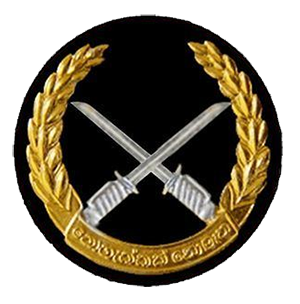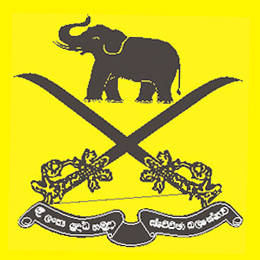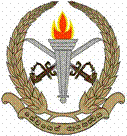The Ceylon Defence Force (CDF) was established in 1910 by the Ceylonese legislation Ceylon Defence Force Ordinance, which reformed the Ceylon Volunteer Force (CVF) that existed previously as the military reserve in the British Crown colony of Ceylon. At the time of forming it was only a reserve force but soon developed into a regular force responsible for the defence of Ceylon. The CDF was under the command of the General Officer Commanding, Ceylon of the British Army in Ceylon if mobilised. However mobilisation could be carried out only under orders from the Governor.

Major General Vanigamuni Indrajith Vijeyakumar Mendis Wimalaratne, RWP, RSP, VSV, USP, psc, GR was a Sri Lankan general. One of the most distinguished field commanders in Sri Lanka, Wimalaratne raised the Gajaba Regiment, he commanded the 1st Brigade during the Vadamarachchi Operation, he commanded the Amphibious Task Force Commander during Operation Balavegaya and was the Commander Security Forces – Jaffna at the time of his death in a land mine explosion at Point Arali in the Kayts Island while making preparations to re-capture Jaffna.

After the outbreak of the Second World War, in the British Crown Colony of Ceylon, the government of Sir Don Baron Jayatilaka assured the British king and his majesty's government of its continued support..

The Sri Lankan Army (SLA) is the oldest and largest of the Sri Lanka Armed Forces. Established as the Ceylon Army in 1949, it was renamed when Sri Lanka became a republic in 1972. In 2010, the Army had approximately 200,000 regular personnel, between 20,000 and 40,000 reserve (volunteer) personnel and 18,000 National Guardsmen and comprises 13 operational divisions, one air-mobile brigade, one commando brigade, one special forces brigade, one independent armored brigade, three mechanized infantry brigades and over 40 infantry brigades. From the 1980s to 2009, the army was engaged in the Sri Lankan Civil War.

The Commando Regiment is the commando formation of the Sri Lanka Army. The unit specializes in various roles including hostage rescue, counter-terrorism, unconventional warfare, special reconnaissance, counter-insurgency, and personnel recovery. It was formed in 1980 and is based in Ganemulla, a suburb of Colombo.

The Sri Lanka Artillery (SLA) is the artillery arm of the Sri Lanka Army. It is made up of ten regular regiments and two volunteer regiments. The SLA is headquartered at Panagoda Cantonment, Panagoda.

The Sri Lanka Sinha Regiment (SLSR) is an infantry regiment of the Sri Lanka Army; it is the second oldest infantry regiment in the army. It is made up of seven regular battalions, five volunteer battalions and a headquarters battalion at the Ambepussa Camp.
The Gemunu Watch (GW) is a infantry regiment of the Sri Lanka Army, formed with troops from the Ceylon Light Infantry and the Ceylon Sinha Regiment in 1962. It has been deployed in many major operations against the LTTE. It is made up of 14 regular units and 9 volunteer units. Headquartered at Kuruwita Army Camp, Ratnapura. It is named after one of the most famous Lankan Kings, King Dutugemunu.

The Sri Lanka Army Volunteer Force (SLAVF) is the active-duty volunteer reserve force of the Sri Lanka Army. The SLAVF is separate from the Regular Force which consists of personal who are professional soldiers and its Regular Reserve, which comprises personal who have a mobilization obligation following their service in the regular army. The SLAVF consists of the volunteer force and the volunteer reserve; administration and recruitment of reserve personal is carried out by the Volunteer Force Headquarters in Shalawa, Kosgama which is headed by the Commandant of the Volunteer Force. It has a current strength of about 55,000 personnel.

The Sri Lanka Army Medical Corps (SLMC) is a specialist corps in the Sri Lanka Army which specializes in military medicine and provides medical services to all army personnel and their families in war and in peace. It is made up of 4 regular units and one volunteer unit. Headquartered in Colombo, formally at army headquarters. The corps Cap badge depicting the Rod of Asclepius. General officers and senior officers of the SLMC wear gorget patches of maroon rather than of scarlet worn by other officers of similar rank.

Diyatalawa is a former garrison town in the central highlands of Sri Lanka, in the Badulla District of Uva Province. It is situated at an altitude of 1,281 m (4,203 ft) and has become a popular destination for local holiday makers. It is home to the Diyatalawa Garrison of the Sri Lanka Army, which includes the Sri Lanka Military Academy, officer training centre of the army; SLAF Diyatalawa, the Sri Lanka Air Force's ground combat training centre; and facilities of the Sri Lanka Police.

The Sri Lanka Military Academy, commonly known simply as Diyatalawa, is one of several military academies in Sri Lanka and is the Sri Lanka Army's initial officer training centre. It is located in the garrison town of Diyatalawa in the central highlands of Sri Lanka. All Sri Lanka Army officers, including army cadets of the General Sir John Kotelawala Defence University, are trained at SLMA. Although not a university, SLMA is affiliated to the General Sir John Kotelawala Defence University to provide its cadets of regular long course a degree in military studies.

Ragama is a suburb of Colombo, located in the Gampaha District, Western Province, Sri Lanka. It is governed by the Ja-Ela Pradeshiya Sabha.
Major General Deshamanya Alexander Richard Udugama, MBE was a Sri Lankan military leader, politician and diplomat. Former Army Commander (1964–1966), he was elected as Member of Parliament for Matale from 1970 to 1977 and served as Sri Lankan Ambassador to Iraq from 1979 to 1982. He was accused of an alleged coup d'état in 1966.
Brigadier Tuan Samayraan Buhary Sally was a Sri Lanka Army officer, who served as the Chief of Staff of the Sri Lanka Army and was the first Malay and Muslim in the country to reach this rank and post.

HMS Uva was a Royal Navy rest camp at Diyatalawa, in British Ceylon.
General Gerard Hector "Gerry" De Silva, RWP, VSV, USP is a Sri Lankan general. He was the 13th Commander of the Sri Lankan Army and Sri Lankan High Commissioner to Pakistan.
Brigadier John Fredrick Halangode, VSV was a Sri Lankan army officer. He founded of the Gemunu Watch, having served as the first commanding officer of the 1st Battalion, Gemunu Watch.
Brigadier Roy Douglas Jayetileke, MBE was a Sri Lankan military leader. He served as the first Commandant of the Army Recruit Training Depot and founding commanding officer of the Sri Lanka Sinha Regiment.
Brigadier Leonard "Lyn" Merlyn Wickramasuriya was a Sri Lanka Army officer, he served as the Commandant, Army Training Centre and Diyatalawa Garrison Commander.












